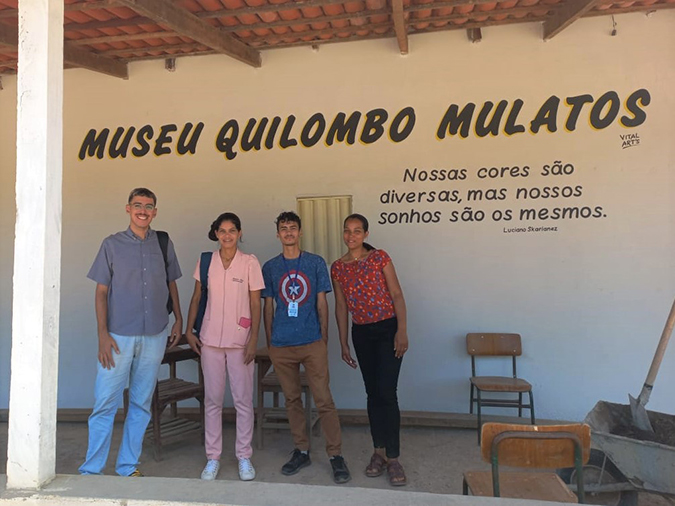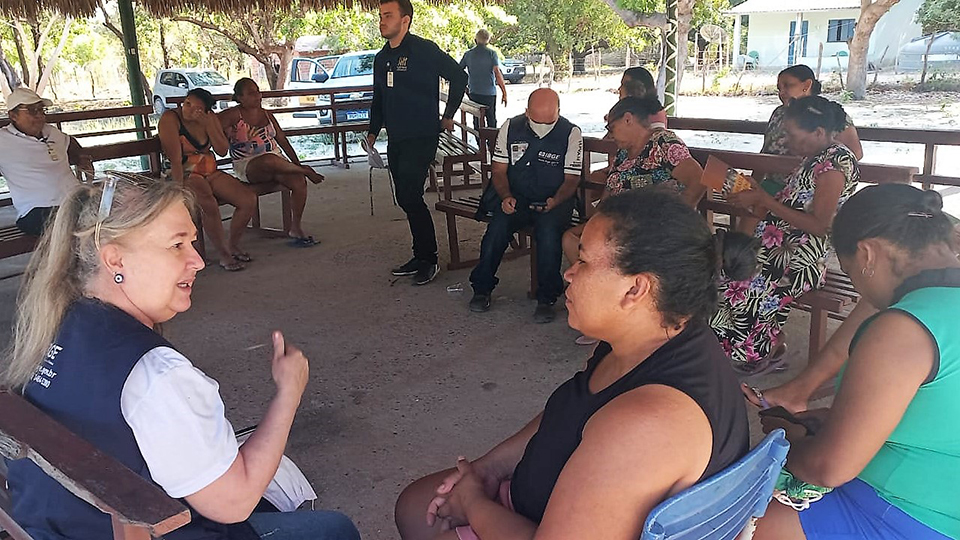Indigenous and quilombola lands in interior of Ceará are visited by IBGE to follow up the Census in their territories
October 25, 2022 12h24 | Last Updated: October 31, 2022 17h02
Since the data began to be collected in Indigenous and quilombola peoples in Ceará, the Technical Coordination of the 2022 Population Census in the state has monitored the work developed in these territories, in order to assure the coverage and the quality of the data. As part of this follow-up, experts are traveling to some of these traditional communities in the state where potential difficulties were pinpointed, in order to understand them and solving them with local leaders.
Among the territories monitored in recent weeks, Quilombola dos Mulatos Community, in the municipality of Jardim-CE, which hosted the IBGE team on September 29, and Córrego João Pereira, which is located between Itarema-CE and Acaraú-CE, and Tremembé de Queimadas Indigenous Lands, in Acaraú-CE, were visited on October 5 and 6, respectively. Anthropologist and Census Analyst of Traditional Peoples and Communities (PCT), Fábio Jota, assesses that these visits were quite positive: “We managed to clarify the communities and secure the authorization of their leaders to continue the data collection. In addition, the presence in the field allows to follow up the work of local teams.”
“Our voice echoed far away”
On September 29, the Quilombola dos Mulatos Community, which is located in the Boca da Mata Hill in the rural area of the municipality of Jardim-CE, hosted the IBGE team, which included the Area Coordinator Joana D’arc Balbino, The Sub-area Census Coordinator (CCS) Tainá Macedo and the PCT Analyst Fábio Jota, among other officials.

Flashes of the IBGE visit to the Quilombola dos Mulatos Community
The visit was required because that community had not been previously mapped by the Territorial Base. It caused the residents to distrust the IBGE, as they would not be duly registered as quilombolas in the Census, leading to the decision of not authorizing the entrance of enumerators in the community. “We visited the community to explain that the fact that they are not in the Territorial Base would not ignore them, since that we would register the locality as quilombola in each address. We showed them the procedure in the Data Collection Mobile Device (DMC) and apologized for the mistake and for failures in the communication; then the entrance of the IBGE in the community was authorized,” explained anthropologist Fábio Jota.
Josiana Pereira, leader of the Mulatos Community, mentions that her people is recognized through a quilombola self-definition certificate issued by Palmares Cultural Foundation in 2021. She considers a major victory the inclusion of her community in the IBGE mapping as well. “Our voice echoed far away and today we enter the Census as a traditional people. This Census will open new horizons for us, it will open doors that are currently closed. We will have the opportunity to have sufficient data to work with the government and thus strengthen our fights, our resistance,” highlights Pereira.

Flashes of the IBGE visit to the Quilombola dos Mulatos Community
The contact with the community was made by CCS Tainá Macedo, who listened to the claim of the group and mediated the solution of the issue. Macedo is very excited with the data collection in the quilombola community. She believes that the IBGE work with traditional peoples is key to provide them visibility. “As the IBGE aims at portraying Brazil, then it should reserve a tiny space in the picture to this population that has already suffered a lot and that still fights for their rights. I am very happy to take part in this, that I will help to portray all this community with their characteristics, their culture and their ethnicity,” celebrates the CCS.
“To show them that we are here, we exist and resist”
On October 5 and 6, the IBGE visited the Córrego João Pereira and Tremembé de Queimadas Indigenous Lands, respectively. The team comprised the officials of the Technical Coordination of the Census Ana Eugênia Ribeiro and Paulo Cordeiro, Sub-area Census Coordinator (CCS) João Carlos Freitas, Area Coordinator Raimundo Rogaciano and PCT Analyst Fábio Jota. To carry out the two visits, the IBGE team also counted with the support of the National Indian Foundation (Funai).
In the case of the Córrego João Pereira Indigenous Land, which is located between the municipalities of Itarema-CE and Acaraú-CE, the visit was only to follow up the data collection. Fernanda Nascimento, a Tremembé indigenous and head of the Francisco Sales do Nascimento Indigenous School, which addresses the community, celebrated the presence of the IBGE. “The Population Census brings the importance of knowing and really recognizing our population in terms of quantity, identification and also tradition. As our Indigenous are still afraid of self-identifying, the mobilization and conversations we are bringing to our population helps this,” points out Nascimento.

Flashes of the IBGE visit to Córrego João Pereira Indigenous Land
In the Tremembé de Queimadas Indigenous Land, in Acaraú-CE, the IBGE presence was required because the map shown in the approach meeting did not match the territory demarcated by Funai, which caused a distrust in the community. They were afraid that part of the residents were not enumerated as Indigenous, even explaining that Areas of Operational Interest (AIOs) covered the entire locality. “To solve this, the Territorial Base created an emergency map demonstrating the limits of the Indigenous Land within the enumeration areas, and decided that a single enumerator will cover all the areas. The meeting was just about this, we showed the new map and assured that the entire Indigenous Land would be enumerated as such,” clarified anthropologist Fábio Jota.

Flashes of the IBGE visit to the Tremembé de Queimadas Indigenous Land
“The IBGE work is very important. It should be made correctly so we can be known as what we really are: Indigenous peoples,” highlights Elaine Cristina do Nascimento about the census collection in her community. Nascimento is a teacher and a leader in her village, and she considers the Census data important to the recognition of their people. “It is important to show those people who say there are no more Indigenous that we are here, we exist and resist,” concludes her.
